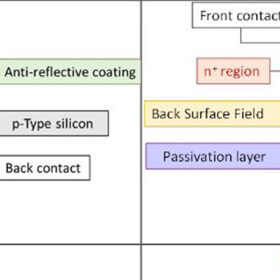As solar photovoltaic (PV) technologies advance, it is essential to comprehend their environmental repercussions to facilitate a sustainable shift towards clean energy. The analysis conducted by IEA PVPS Task 12 delves into the environmental impact of passivated emitter and rear cell (PERC) technology in PV installations, contrasting it with monocrystalline silicon technology (Al-BSF). The study also explores the growing preference for horizontal single-axis tracker systems over fixed tilt systems. Primary data from a PERC and tracker manufacturer underpin the study’s findings. By employing the life cycle assessment (LCA) methodology, the research scrutinizes two locations in Italy with varying irradiation patterns to assess the sensitivity to solar irradiation. The results indicate that PERC technology and horizontal single-axis tracker systems exhibit lower environmental footprints compared to Al-BSF and fixed tilt configurations.
In 2022, global solar PV generation experienced an unprecedented upsurge, with a record increase of 270 TWh, reaching nearly 1,200 TWh worldwide. This surge underscores the pivotal role of solar energy in meeting escalating global electricity demand while mitigating greenhouse gas emissions. The transition from aluminum-back surface field (Al-BSF) cell technology to the more advanced PERC technology a decade ago fueled this growth. PERC technology, characterized by an additional dielectric passivation stack on the rear of the cell and potential bifaciality, has superseded older structures like Al-BSF due to its enhanced efficiency gains in both PV cells and modules. Furthermore, there has been a notable uptick in the adoption of Horizontal Single Axis Tracker systems, which offer higher kWh production per kW installed compared to fixed-tilt systems across various locations. This shift towards more efficient PV systems underscores a commitment to sustainable energy solutions.
Environmental Impact Evaluation
While the energy production aspects of PV technologies have been extensively studied, understanding their environmental footprint is crucial. IEA PVPS Task 12 experts have been utilizing the LCA methodology to assess the environmental impacts of PERC technology compared to AI-BSF technology. Leveraging primary data from an Italian manufacturer, the study provides a comprehensive analysis of the complete life cycle of PV systems, spanning manufacturing, installation, operation, and end-of-life phases. Despite being based on data from a single manufacturer, the findings suggest that transitioning from Al-BSF to PERC technology yields substantial reductions in greenhouse gas emissions, energy consumption, and resource depletion across the PV system’s life cycle.
“The primary focus of our report is to scrutinize the impacts of the predominant technology in photovoltaics, employing the LCA methodology and integrating primary and current data,” stated Pierpaolo Girardi, co-Author of the report. “This approach enables us to affirm that electricity generated by PERC technology from an Italian company has a 15% lower carbon footprint compared to electricity production using the currently most installed PV technology (Al-BSF) and a 96% reduction compared to electricity from a typical Italian natural gas combined cycle power plant.”
Life Cycle Assessment Methodology
LCA is a structured method for quantifying material and energy flows and their associated emissions throughout the life cycle of goods and services. The ISO 14040 and 14044 standards provide the framework for LCA. IEA PVPS Task 12 has developed guidelines, now in their 4th edition, to ensure consistency, balance, and quality in LCA results on PV electricity generation systems.
Revealing the Environmental Footprint
The Task 12 experts analyze two designs in their report: modules mounted on a horizontal single-axis tracker and modules on a fixed structure. They consider two PV locations with different irradiance levels in Italy, with the results presented here reflecting Southern Italy. The impressive results, based on primary data from one manufacturer, include:
- Greenhouse Gas Emissions: The shift from Al-BSF to PERC technology can reduce greenhouse gas emissions per kWh produced across both locations. The additional passivation layer in PERC cells enhances energy conversion efficiency, leading to a lower carbon intensity in electricity generation. Moreover, the adoption of single-axis solar tracker systems amplifies this environmental benefit, as the increased energy yield per kW installed results in lower emissions per unit of electricity produced.
The PERC PV plant in Southern Italy emits 17 g of CO2 equivalent per kWh produced. This figure illustrates the contribution analysis of the PERC PV plant based on primary data from an Italian PERC manufacturer. The comparison with a typical natural gas power plant in Italy highlights the significant difference in greenhouse gas emissions per kWh produced by each plant.
- Energy Consumption: Transitioning to PERC technology is accompanied by a notable decrease in total energy consumption throughout the PV system’s life cycle. Enhanced cell efficiency and manufacturing processes contribute to this reduction. Additionally, horizontal single-axis tracker systems offer higher energy yields per unit of land area, optimizing energy production and minimizing energy consumption per kWh generated.
- Resource Depletion: Despite relying on a similar set of materials, PERC technology’s efficiency improvements mitigate resource depletion impacts. By maximizing energy output per unit of material input, PERC technology reduces the extraction and utilization of finite resources, easing pressure on critical minerals and metals.
Advancing Towards Sustainable Solar Energy
The study underscores the environmental advantages of PERC technology. By adopting PERC, the solar industry can decrease greenhouse gas emissions, energy consumption, and resource depletion while enhancing energy yields. The analysis of different mounting systems indicates that modules on a horizontal single-axis tracker can lead to favorable environmental outcomes, especially in latitudes akin to Italy. Moreover, a sensitivity analysis in the Task 12 report suggests that extending the lifetime of PV panels can further reduce specific environmental impacts per kWh, emphasizing the importance of panel longevity in performance.
Efforts to promote environmentally responsible technologies and optimize site selection can maximize solar energy’s potential as a cornerstone of the clean energy transition.
